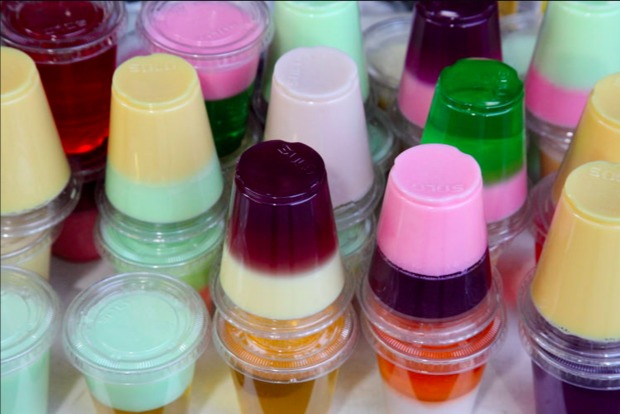Spring draws food vendors of all kinds out onto the streets of New York City.
Some advertise their wares with written signs, others with pictures, and a smaller contingent with no symbols at all.
In neighborhoods where vendors sell food native to the surrounding community's home countries, "it’s very common that the signage is simply the food itself," said Dave Cook, a photojournalist whose website, Eating in Translation, has chronicled his exploration of lesser-known foods in the New York City area since 2005.
"For passersby who don’t share that affinity, street foods like these ... are often largely ignored," Cook added, speaking earlier this month at a New School panel on the subject.
That generalization obviously doesn't apply to the Morningside Heights resident and self-trained culinary anthropologist.
Cook launched his website more than a decade ago to keep notes on his adventures and as a reference for friends seeking dining recommendations.
It evolved over the years, he said, into "a way of expanding the view I had of the city, of making connections between different New York City neighborhoods and between other cultures as they had been transplanted by natives of those countries and transformed here.
We asked him to share with us some insight into New York City's multicultural street food, which, as he put it, is often "offered with less signage, but more of the context of color, of music, of language, of community."
Cook's picks are from the Caribbean and a variety of Latin and South American countries, but he noted that the city is home to street foods from all over the world. It's just that the dishes and treats featured below are presented unlabeled more often than other cuisines.
Below you'll find our guide to 10 foods and drinks Cook has spotted on the streets of the city's neighborhoods without signs of any kind and where exactly to find them:
Humitas

Country of origin: Ecuador
Where to find it: Warren Street, south of Roosevelt Blvd, Elmhurst, Queens
This "tamale-like Ecuadorian dish made of corn," in Cook's words, is steamed in corn husks. A display with corn cobs telegraphs the message that the humitas are freshly made.
Tamarind Candies

Country of origin: Mexico
Where to find it: at the intersection of 5th Avenue and 49th Street, Sunset Park
Shape and color are the keys to choosing the tamarind candy you'll like best. If you like spicy, the red candies are the way to go. The disks are salty, while the balls are sweet.
Mabi

Region of origin: the Caribbean
Where to find it: Liberty Avenue, east of the Van Wyck Expressway, Jamaica
You can identify roadside stands selling mabi by the sugarcane stalks leaning against them, and you can recognize the drink itself by the foam that forms on the caps of its containers.
”Although it’s not alcoholic in the legal sense, it’s fermenting, pressure is building, and you need to put pinholes in the top of the jugs so the pressure has some place to go," Cook explained.
The beverage is made from the bark of the mabi tree, which grows throughout the Caribbean. It's got a flavor similar to root beer. Serious Eats likens the flavor to "a spiced and sweetened chai or apple cider, only carbonated."
Espumilla
Country of origin: Ecuador
Where to find it: Roosevelt Avenue, between 82nd Street and Junction Boulevard, Jackson Heights
Don't be fooled: you're not ordering ice cream.
"A very loose meringue, usually served in a cone," as Cook described it, this dessert is typically made with guava fruit pulp, egg whites and sugar. Its name, "espumilla," means "foam" in Spanish.
Habichuelas con Dulce

Country of origin: Dominican Republic
Where to find it: St. Nicholas Avenue between 180th and 184th Streets, Washington Heights
Often stored in orange plastic water coolers, this sweet Dominican beverage is traditionally prepared from red beans for Lent, but you can find it all year round.
The drink has a "coconut milk-like consistency," Cook said, and is served with milk crackers on top.
Cuy al Palo

Country of origin: Peru
Where to find it: The eastern side of Flushing Meadows Corona Park, between the Pool of Industry and the Van Wyck Expressway, Flushing
Roasted guinea pig is a specialty in Peru, where the rodent has been a staple of local diets for the last 5,000 years.
In Cook's opinion, the meat of the cuy, which is pronounced "kwee," tastes like turkey "in the richer dark-meat sense."
Nieve

Country of origin: Mexico
Where to find it: 5th Avenue between 40th and 50th Streets, Sunset Park
Vendors in Sunset Park sell this Mexican sorbet — or "snow," as its name translates from Spanish.
Sometimes, vendors display empty plastic cups coated with chili powder, prepared in advance for customers who like their nieve with a kick.
Alcapurrias

Country of origin: Puerto Rico
Where to find it: St. Nicholas Avenue between 180th and 184th Streets, Washington Heights
You can recognize this Puerto Rican fritter by its torpedo shape, Cook said.
Its fried dough exterior is made from mashed green plantains or grated yuca. One bite reveals a filling of ground beef or pork.
Gelatinas

Country of origin: Mexico
Where to find it: near the Morisson Avenue-Sound View subway station, Soundview
These gelatin desserts come in all kinds of flavors, some of which are concocted with water, others with sweetened condensed milk.
Obleas

Country of origin: Colombia
Where to find it: at the intersection of Roosevelt Avenue and 82nd Street, Jackson Heights
An oblea is a Colombian dessert that served plain would be "only slightly more flavorful than a communion wafer," in Cook's words. Kids will patiently wait on line for the treat when it's topped with a caramel spread called arequipe.


























